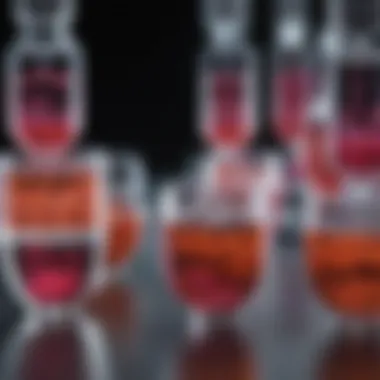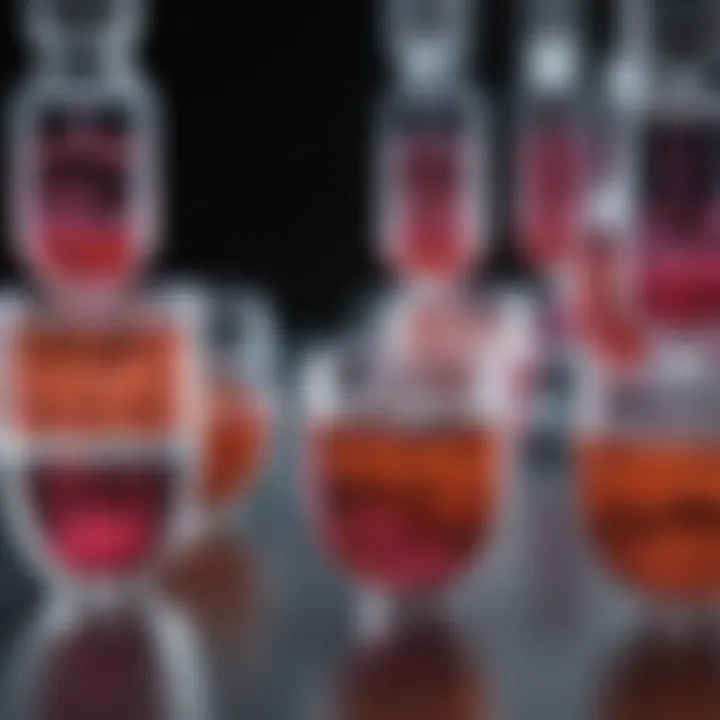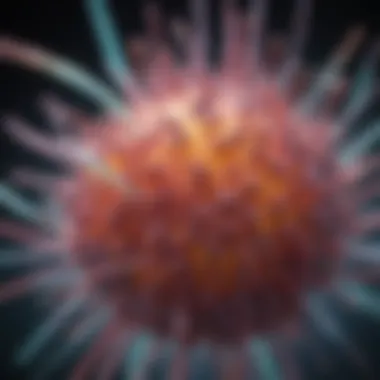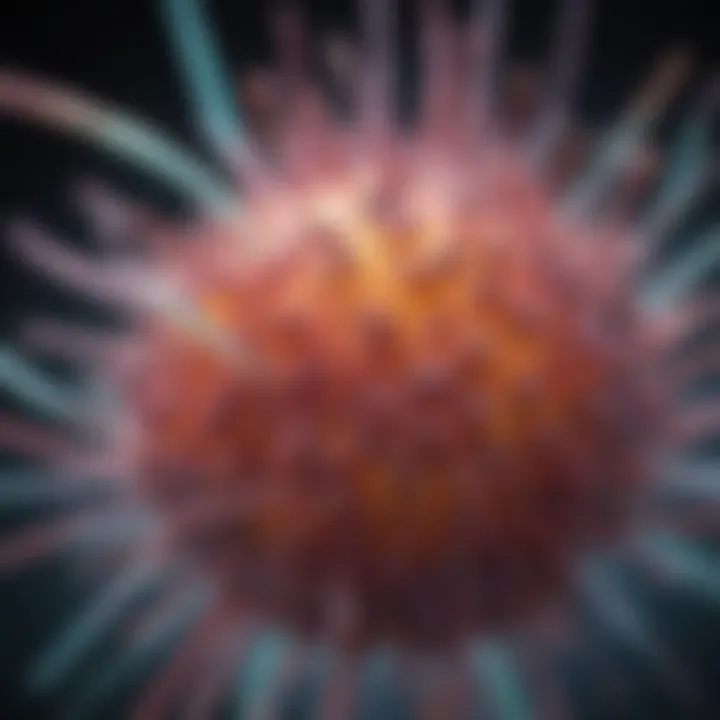Fluorescence Immunoassay: Mechanisms and Future Directions


Intro
Fluorescence immunoassays represent a pivotal technique, bridging several scientific domains, from clinical diagnostics to environmental monitoring. At its core, this method leverages the unique properties of fluorescent labels to enhance detection and quantification of specific biomolecules. Understanding the intricacies of these assays not only illuminates their efficacy but also fosters appreciation for their growing impact across various sectors.
Article Overview
Fluorescence immunoassays operate through a fascinating mechanism that pairs antibodies with fluorescent dyes. When these antibodies bind to their specific antigens, the resulting complex can be detected and measured based on its fluorescence.
Summary of Key Findings
- Fundamental Mechanisms: Insights into the binding interactions between antibodies and antigens greatly underpin the operation of FIA, providing clarity on how fluorescence can be utilized effectively.
- Applications Across Fields: From the lab to the field, the versatility of FIA in clinical settings, environmental analysis, and research makes it a go-to for various professionals.
- Future Innovations: Emerging technologies promise to enhance sensitivity and specificity, ushering a new era for fluorescence immunoassays.
Research Objectives
The main aim of this article is to break down the principles of FIA, explore its application spectrum, weigh the trade-offs, and chart a potential roadmap for future advancements. What sets this apart is the combination of in-depth analysis and practical illustrations that cater to an audience ranging from students to seasoned professionals.
Key Results and Discussions
Main Findings
The essence of fluorescence immunoassay technology lies in its efficiency and sensitivity. Recent research has illuminated several notable findings:
- High Sensitivity: Fluorophore-conjugated antibodies can detect minute amounts of biological markers, making them invaluable for early disease detection.
- Diverse Format Utilization: Various assay formats, including sandwich and competitive assays, cater to an array of biological questions, broadening their utility.
Implications of Findings
The implications of these findings are profound:
"The continued evolution of fluorescence immunoassays will redefine diagnostics and environmental monitoring, driving breakthroughs in health and safety."
- Clinical Applications: The ability to detect diseases rapidly can significantly alter treatment pathways and patient outcomes.
- Environmental Monitoring: In the face of climate and ecological changes, FIA provides a tool to track pollutants and pathogens, empowering scientists and public health officials.
In closing, fluorescence immunoassays are more than just a tool; they are a cornerstone of modern science and industry, heralding a future ripe with possibilities. The intersections of biology, chemistry, and technology remain fertile ground for innovation.
Prolusion to Fluorescence Immunoassay
Fluorescence immunoassay (FIA) represents a significant stride in the realm of analytical science. At its core, FIA combines principles of immunology and fluorescence to detect specific antigens within a sample. This multi-faceted approach has broadened possibilities across various domains, from clinical diagnostics to environmental assessments. Given the increasing demand for rapid and accurate testing methods, understanding the ins and outs of this technique is vital for both professionals and researchers.
Definition and Historical Background
Fluorescence immunoassay can be defined simply as a method that utilizes fluorescently labeled antibodies to detect the presence of specific antigens in a given sample. The historical journey of FIA is quite fascinating and marks a transformative step in biochemical detection methods. The initial developments of this technique trace back to the 1970s when the first applications of fluorescent labels in immunoassays were demonstrated.
This period was anything but straightforward, as early research grappled with the complexities of identifying antibodies that could bind specifically to target antigens while maintaining the stability of fluorescent molecules. Over time, as technology progressed, improvements were made in fluorescent dyes and imaging systems. The fusion of sophisticated optics and photo-detection techniques propelled FIA into the spotlight, enabling higher sensitivity and specificity.
Fundamentals of Fluorescence
To fully grasp the intricacies of fluorescence immunoassays, one must first understand the fundamentals of fluorescence itself. Fluorescence occurs when a substance absorbs light at one wavelength and then re-emits it at a longer wavelength. This physical phenomenon provides the backbone for many biochemical applications, including FIA.
The process can be summarized as follows:
- Excitation: When light strikes a fluorophore (the fluorescent compound), it elevates electrons to a higher energy state.
- Emission: As the excited electrons return to their ground state, they release energy in the form of light at a longer wavelength.
Thus, the brilliance of fluorescence lies in its ability to translate biochemical interactions into detectable signals. In FIA, the integration of this principle allows for the rapid and direct measurement of an analyte's presence, thus streamlining various testing processes.
Fluorescence may appear straightforward, but to get it right, one needs a thorough understanding of optical properties, light paths, and the nature of the fluorescent labels used. The ability to differentiate between various labels based on their emission spectra allows researchers and practitioners to refine and enhance the specificity of their assays.
Furthermore, the versatility offered by fluorescence extends to the development of multiplex assays, where multiple targets can be analyzed simultaneously. This capability is skyrocketing the efficacy of analyses in clinical diagnostics and other pertinent fields.
Mechanisms of Fluorescence Immunoassays


The mechanisms behind fluorescence immunoassays (FIAs) are at the heart of their application across various fields. Understanding these mechanisms not only enlightens their operational efficiency but also showcases their value in both research and clinical settings. As we navigate through this section, we'll delve into the principles governing the interactions between antigens and antibodies, the pivotal role of fluorescent labels, and the detection methodologies that breathe life into these assays. Each of these elements contributes to the overall efficacy and specificity of FIAs, making them indispensable tools for precise diagnostics and monitoring.
Principles of Antigen-Antibody Interactions
At the core of FIAs are the interactions between antigens and antibodies. This relationship is akin to the way a lock fits a key. Antigens, which are typically proteins or polysaccharides, present a unique structure that antibodies precisely recognize. This specificity arises from the unique binding sites on each antibody, allowing it to latch onto a corresponding antigen with remarkable accuracy. This interaction is essential for the assay's success since it dictates the effectiveness of detection.
- Affinity and Specificity: The strength of this interaction, known as affinity, is critical. High-affinity interactions lead to more reliable results. The concept of specificity ensures that assays target only the intended antigens and avoid cross-reactivity that could skew results.
- Conformational Changes: When an antibody binds to an antigen, it can trigger conformational changes that enhance detection. These changes impact how fluorescent labels function, offering a tangible signal for the assay's readout.
- Temperature and pH Influence: Environmental factors, such as temperature and pH, can also affect antigen-antibody binding. Maintaining optimal conditions is key to ensure robust and repeatable results.
By understanding these principles, researchers can formulate better assays tailored to their specific targets, improving detection rates across applications.
Role of Fluorescent Labels
Fluorescent labels are vital players in fluorescence immunoassays. Think of them as the stars of the show, illuminating the pathway to successful detection. These labels are usually attached to antibodies or antigens, providing a visual cue when the target interactions take place.
- Types of Labels: There are various types of fluorescent labels, including dyes like fluorescein and rhodamine. Each offers unique properties such as different excitation and emission wavelengths, which allows for multiplexing—detecting multiple targets in a single assay.
- Stability and Photobleaching: The stability of these labels is paramount. Photobleaching, the loss of fluorescence due to prolonged exposure to light, can be a significant limitation. A stable fluorescent label can enhance the assay's reliability by providing consistent signals over time.
- Detection Sensitivity: The choice of fluorescent label directly impacts the sensitivity of the assay. High-quantum yield labels provide a stronger signal, making it easier to detect low-abundance targets with precision.
Essentially, fluorescent labels bridge the gap between the biochemical interaction and visual detection, making them indispensable in assays.
Detection Methods
Detection methods in FIAs encompass a variety of techniques that convert the binding events into measurable signals. These techniques vary widely in complexity and application, providing flexibility in assay design.
- Fluorescence Microscopy: This method leverages optical systems to visualize the fluorescent signal. It’s particularly useful in research environments where understanding the spatial distribution of targets is crucial.
- Flow Cytometry: Used extensively for clinical diagnostics, flow cytometry allows simultaneous analysis of multiple parameters at high speed. It quantifies fluorescent signals from cells as they pass through a laser beam, offering rapid and detailed results.
- Plate Readers: In high-throughput settings, plate readers are commonly employed. These instruments can measure fluorescence across numerous samples efficiently, making them essential for screening applications.
- Surface Plasmon Resonance (SPR): While not strictly fluorescent, SPR techniques can complement FIAs, providing insights into the dynamics of antigen-antibody interactions.
"Integration of these detection methods can optimize the performance of fluorescence immunoassays, tailoring them for specific applications across diverse fields."
In summary, each detection method presents unique benefits and considerations, enabling researchers to select the most appropriate approach for their specific applications. By understanding these mechanisms, one can better appreciate the broader significance of fluorescence immunoassays in pushing the boundaries of diagnostics.
Types of Fluorescence Immunoassays
Understanding the various types of fluorescence immunoassays (FIAs) is paramount for researchers and practitioners in fields like clinical diagnostics, environmental monitoring, and food safety testing. Each type brings distinct advantages and is tailored to specific applications, ultimately shaping how we gather and interpret data. The choice of FIA format impacts sensitivity, specificity, and the overall efficacy of testing methodologies.
Choosing the correct format allows for precise control over the assay conditions, optimizing detection capabilities while minimizing potential interference. The following sections break down the main types of FIAs, examining their unique characteristics, benefits, and specific use cases.
Direct Fluorescence Immunoassays
In direct fluorescence immunoassays, the target antigen is directly labeled with a fluorescent dye. When the sample containing the antigen is exposed to light at a specific wavelength, the dye emits fluorescence. This method is relatively straightforward and allows for quick results, making it ideal for rapid testing scenarios.
Key Characteristics:
- Simplicity: Fewer steps in the protocol often lead to easier optimization.
- Quick results: Suitable for high-throughput settings where time is of the essence.
- Less background noise: Direct labeling minimizes the potential for non-specific binding.
However, one should consider limitations such as lower sensitivity when working with low-abundance analytes. It might not always provide ample signal strength, especially in complex biological samples.
Indirect Fluorescence Immunoassays
Indirect fluorescence immunoassays involve a two-step process where an unlabeled primary antibody binds to the target antigen, followed by the introduction of a fluorescently labeled secondary antibody that recognizes the primary antibody. This method amplifies the signal through the use of additional antibodies, allowing for greater sensitivity.
Advantages:
- Enhanced sensitivity: The presence of multiple secondary antibodies can lead to a stronger fluorescent signal.
- Greater versatility: Different primary antibodies can be used with the same labeled secondary antibody, reducing costs associated with multiple fluorescent labels.
Still, the increased complexity and potential for increased background signal require careful optimization of both antibodies to achieve reliable results.
Sandwich Fluorescence Immunoassays
In sandwich fluorescence immunoassays, two antibodies are employed to create a "sandwich" around the target antigen. The first antibody captures the antigen, and the second antibody, which is attached to a fluorescent label, follows suit. This method is particularly effective for larger antigens, allowing for specific detection amidst complex mixtures.
Benefits:
- High specificity and sensitivity: The dual-antibody approach ensures that only the correct analyte is detected.
- Robustness: This format is well-suited for a variety of sample types, including serum and tissue extracts.


However, it is crucial to ensure that the antibodies do not interfere with each other, as cross-reactivity can compromise assay accuracy.
Competitive Fluorescence Immunoassays
Competitive fluorescence immunoassays employ a slightly different mechanism where the sample's target competes with a fluorescently labeled antigen for binding sites on a specific antibody. The more target present in the sample, the less fluorescently labeled antigen will bind, thus diminishing the fluorescent signal.
Unique Aspects:
- Quantitative analysis: The amount of fluorescence directly relates to the concentration of the target antigen, allowing for easy interpretation of results.
- Application in low-abundance analytes: These assays can be favorable for scenarios where the analyte is scarce, providing a robust framework for detection.
While they can provide highly accurate and sensitive measurements, careful calibration is necessary to ensure reliable quantification, especially in a mixed sample scenario.
"Fluorescence immunoassays continue to evolve to meet the stringent demands of various scientific disciplines, driving innovation and improving testing practices."
Applications of Fluorescence Immunoassays
Fluorescence immunoassays (FIA) play a pivotal role in diverse fields, facilitating a range of applications that harness their sensitivity and specificity. Understanding these applications is essential, not only to appreciate the breadth of FIA’s impact but also to recognize potential innovations that can enhance their usefulness in various sectors. The significance of FIA spans clinical diagnostics, environmental monitoring, research laboratories, and food safety testing. Each of these areas demonstrates how fluorescence immunoassays can tackle specific challenges, promote efficiency, and yield reliable results.
Clinical Diagnostics
In clinical diagnostics, fluorescence immunoassays are a game-changer. These assays are used to detect biomarkers for diseases, such as cancer, autoimmune disorders, and infectious diseases. For instance, the identification of specific antibodies or antigens allows clinicians to diagnose conditions early, leading to timely interventions. With the surge of personalized medicine, FIA's sensitivity enables the detection of minute concentrations of biological markers, tailoring treatments to individual needs.
- Speed and Efficiency: Unlike traditional methods, which can be time-consuming, FIAs offer rapid results. This swiftness is crucial when dealing with infectious diseases like COVID-19.
- High Throughput: Laboratories can process numerous samples simultaneously, which is especially beneficial in settings such as hospitals or during outbreak responses.
However, while the advantages are pronounced, challenges persist. Issues like the presence of interfering substances in samples can skew results. It’s vital for clinicians to remain aware of these limitations and calibrate assays accordingly.
Environmental Monitoring
Fluorescence immunoassays are not confined to medical applications; they extend significantly into environmental monitoring. These assays are employed to detect pollutants, toxins, and pathogens in water, soil, and air samples.
- Case in Point: For example, detection of pesticides in agricultural runoff. Using FIA, researchers can swiftly identify harmful residues that threaten ecosystems and human health.
- Quick Assessments: Detecting contaminants allows for prompt actions to prevent environmental disasters, such as algal blooms in water bodies.
The pressing global issue of climate change makes environmental monitoring increasingly crucial. As regulations tighten and awareness grows, the role of FIA in tracking environmental compliance will only expand.
Research Laboratories
In research laboratories, fluorescence immunoassays are indispensable tools. Researchers frequently utilize FIAs for experiments requiring high sensitivity and specificity, ranging from the study of cellular responses to drug development.
- Versatile Applications: Whether it’s studying protein interactions or quantifying cytokine release from immune cells, FIAs provide valuable data crucial for breakthroughs.
- Customization: Researchers can tailor these assays to fit specific needs by varying fluorescent tags, allowing for an array of applications from basic research to clinical trials.
The integration of FIAs into research hastens discoveries. Yet, the skill set required cross-disciplinary knowledge, often necessitating collaborations among scientists from various fields.
Food Safety Testing
Food safety is a critical concern globally, and fluorescence immunoassays have carved out a niche in ensuring food quality and safety. With the ability to detect pathogens and contaminants quickly, these assays provide a vital resource for food safety inspectors.
- Examples Include: Detecting E. coli or Salmonella in food samples, ensuring that products meet safety standards before reaching consumers.
- Real-Time Results: The speed of FIAs enables rapid decision-making in food production settings, reducing the likelihood of outbreaks.
Given the increasing scrutiny on food safety, the application of FIAs remains paramount. It’s a fast-paced field, and continued innovation could lead to even more efficient methods for food safety assessments.
"Fluorescence immunoassays exemplify how technology can evolve to meet public health needs, be it in diagnostics or food security."
Advantages and Limitations
Understanding the advantages and limitations of fluorescence immunoassays (FIA) is paramount when evaluating their overall efficacy and applicability in various fields. This section delves into the favorable traits that set FIAs apart, alongside the challenges that researchers and practitioners may face in implementing these assays. Recognizing both the strengths and weaknesses of this technology is essential for making informed decisions in research, clinical, and environmental settings.
Benefits of Using Fluorescence Immunoassays
Fluorescence immunoassays boast a spectrum of advantages that contribute to their widespread adoption in many domains. Here are some key benefits:
- Sensitivity: FIAs are known for their high sensitivity, enabling the detection of low concentrations of targets, which is crucial in clinical diagnostics where precision matters.
- Specificity: The specific antigen-antibody interactions utilized in FIAs ensure that results are not easily confounded by unrelated substances, enhancing the reliability of the results.
- Versatility: From clinical diagnostics to environmental monitoring, FIAs can be adapted to work with various sample types, including blood, urine, and even environmental samples like water. Such versatility makes them an appealing choice across multiple disciplines.
- Rapid Results: Many fluorescence immunoassays offer quick turnaround times, allowing for timely analysis and decision-making, particularly in clinical settings.
- Multiplexing Capabilities: Advancements in technology now allow for multiplex assays, enabling the simultaneous detection of multiple analytes within a single sample. This can greatly increase efficiency and reduce costs.


These benefits underline why FIAs have become a mainstay in various applications, particularly in clinical diagnostics where time, accuracy, and sensitivity are critical factors.
Challenges in Implementation
Despite the numerous advantages, implementing fluorescence immunoassays does not come without its challenges. Awareness of these hurdles is vital for researchers and practitioners. Some challenges include:
- Reagent Stability: Fluorescent labels and other reagents may have stability concerns, leading to degradation and affecting assay reliability over time.
- Interference: Certain substances present in samples, such as other proteins or environmental factors, can interfere with the fluorescence signal, potentially skewing results.
- Instrumentation Cost: The equipment necessary for detecting fluorescence signals can be expensive to purchase and maintain, which may limit accessibility for some labs, especially those with tight budgets.
- Complexity of assay development: Designing a robust fluorescence immunoassay can require extensive optimization, and it may take a significant time and resources to tailor an assay to specific needs effectively.
- Training Requirements: Proper implementation of FIAs requires staff training to ensure that they understand the underlying principles and operation of the equipment, which can be a barrier in certain settings.
"Recognizing and addressing the limitations of fluorescence immunoassays is essential for their successful application in the field."
In summary, while fluorescence immunoassays present numerous advantages such as high sensitivity and specificity, challenges like reagent stability and instrumentation costs cannot be overlooked. A balanced understanding of these aspects can aid in optimizing the use of FIAs for future applications.
Recent Advances in Fluorescence Immunoassays
The realm of fluorescence immunoassays (FIAs) is rapidly evolving, spurred by technological innovations and the ever-growing need for precise diagnostic methods. This section delves into the significance of recent advancements in FIAs, illuminating how these breakthroughs are pushing boundaries and setting new standards. Keeping an eye on these developments is essential, as they contribute greatly to various applications ranging from clinical diagnostics to environmental monitoring.
Emerging Technologies
One of the most noteworthy aspects of recent advances in FIAs is the emergence of novel technologies. Here’s where the rubber meets the road. Enhanced microscopy techniques and advanced imaging systems are now enabling researchers to observe reactions in real-time with unprecedented cell-specific resolution.
- Nano-sized Fluorophores: These tiny tags provide stronger signals and improved sensitivity, opening doors for applications previously deemed challenging. Their small size allows for better binding efficiency and signal amplification, which is crucial for detecting low-abundance targets.
- Quantum Dots: As fluorescent materials that exhibit unique optical properties, quantum dots have transformed the detection of biomolecules. Unlike traditional dyes, they offer broad absorption spectra and narrow emission peaks, which make them extremely useful in multiplexing applications.
- Microfluidic Systems: Integrating FIAs into microfluidic devices allows for rapid and efficient analyses. Such systems facilitate the processing of small samples while maintaining high sensitivity, which is a game-changer in diagnostics.
These technologies not only improve the overall performance of FIAs, they also expand their versatility, making them suitable for a variety of scientific inquiries and clinical applications.
Multiplexing Applications
Multiplexing, or the ability to detect multiple analytes simultaneously, represents a significant leap in the capabilities of fluorescent immunoassays. This advancement is particularly relevant in the face of challenges posed by complex biological samples.
With multiplexing, we can provide:
- High-throughput analysis: Researchers can analyze multiple targets in a single experiment, saving time and resources.
- Comprehensive profiling: It enables the assessment of multiple biomarkers, which can give a clearer clinical picture and inform treatment decisions.
For instance, in oncology, a multiplexed FIA can simultaneously quantify different tumor markers. This holistic approach leads to more personalized medicine, which is a crucial step towards improving patient outcomes.
Future Directions in Fluorescence Immunoassays
The realm of fluorescence immunoassays is continuously evolving, driven by advances in technology and a growing understanding of their mechanisms. The future directions highlighted here are poised to enhance the efficacy and scope of these assays across numerous sectors. This focus is crucial as it not only sheds light on innovations that are on the brink of realization but also reflects on how they can positively reshape industries ranging from healthcare to environmental science.
Innovations on the Horizon
Focusing on innovations emerging within fluorescence immunoassays, several trends are rising. One of the standout advancements includes the introduction of nanotechnology, which plays an instrumental role in enhancing fluorescent signal intensity. Nanoparticles, especially, can offer brighter fluorescence properties, often surpassing traditional fluorophores in sensitivity, which may lead to more precise detection at lower concentrations of target antigens.
Furthermore, the integration of microfluidics into fluorescence immunoassays is transforming how samples are handled. These compact devices allow for the manipulation of small volumes of fluids, significantly speeding up the processing time and reducing the amounts of reagents needed. This is particularly advantageous in clinical settings where time is often of the essence.
Additionally, the trend towards multiplexing—where multiple analytes can be detected in a single test—holds enormous potential. This approach not only decreases the time and costs associated with conducting several separate assays but also provides a comprehensive profile of biomarkers, hence improving diagnostic accuracy. Innovations related to imaging techniques, such as super-resolution microscopy, can take this multiplexing to new heights, allowing for detailed observations of molecular interactions in real-time.
Potential Impact on Healthcare
The implications of advances in fluorescence immunoassays, particularly in healthcare, cannot be overstated. Enhanced sensitivity and specificity can significantly elevate the diagnosis and monitoring of diseases. For instance, if future designs enable earlier detection of diseases such as cancer or autoimmune disorders, healthcare providers can initiate treatment sooner, potentially leading to better patient outcomes.
Moreover, as fluorescence immunoassays become more accessible and cost-effective, they have the potential to support point-of-care testing significantly. This means that in remote or resource-limited settings, rapid and reliable diagnostic tools could be utilized, enabling immediate clinical decisions without the need for advanced laboratory facilities.
The growing trend towards personalized medicine also dovetails nicely with innovations in fluorescence immunoassays. By providing detailed insights into individual patients’ biomarker profiles, tailored therapies can be developed, thus moving away from a one-size-fits-all approach. In this context, the fine-tuning of fluorescent labels and the development of new assay formats could offer significant benefits, meeting the individual needs of patients more efficiently.
"As we step into a new era, the role of fluorescence immunoassays in healthcare may pivot from merely diagnostic tools to pivotal components in the management of diseases."
The End
As we wrap up this exploration of fluorescence immunoassays, it's crucial to recognize their central role in the landscape of modern science and healthcare. This technique not only streamlines the process of identifying target antigens but also elevates the sensitivity and specificity of such detections to new heights. With a growing emphasis on precision medicine and real-time diagnostics, the importance of fluorescence immunoassays cannot be overstated. They represent an intersection of scientific innovation and practical application, allowing for advancements in clinical diagnostics, environmental monitoring, and even in research laboratories that push the boundaries of understanding.
Summary of Key Points
- Mechanism of Action: Fluorescence immunoassays operate on complex antigen-antibody interactions, where the incorporation of fluorescent labels enhances visibility and measurement accuracy.
- Diverse Applications: From clinical diagnostics to food safety, the versatility of fluorescence immunoassays opens doors for innovative testing solutions across various sectors.
- Recent Advancements: The exploitation of emerging technologies, such as multiplexing, has ushered in a new era, increasing throughput and efficiency in testing environments.
- Challenges Faced: Despite their many benefits, the field encounters hurdles such as optimization, regulatory approval, and the need for continuous improvement to address diverse testing needs.
- Future Directions: Looking ahead, researchers are focused on refining these assays, with expectations of even greater specificity and adaptability in diagnostics.
Final Thoughts
Reflecting on the breadth of information presented, fluorescence immunoassays exemplify a remarkable blend of theoretical principles and practical application. Their ongoing evolution points not only to a brighter future in detection technology but also to the potential for making significant contributions to global health initiatives. As the demand for quick and reliable testing solutions continues to rise, embracing and investing in fluorescence immunoassay technologies seems not just rational but essential.







